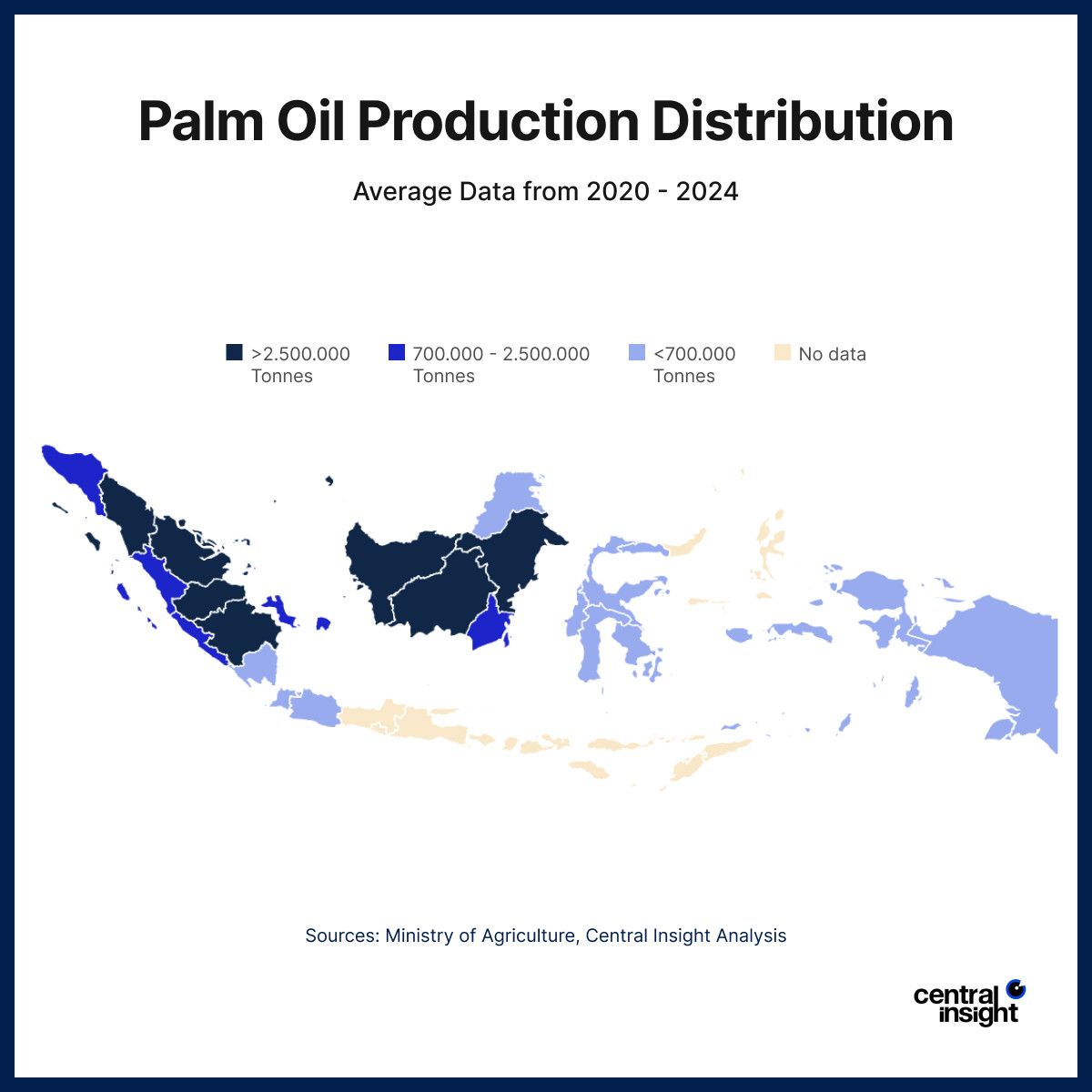Indonesia’s palm oil industry remains one of the nation’s economic cornerstones, supporting millions of livelihoods and contributing significantly to export revenues. Yet, despite discussions about diversification and sustainability, one fact remains unchanged: the islands of Sumatra and Kalimantan continue to dominate Indonesia’s palm oil production, accounting for over 80% of the country’s total output.
According to data compiled by the Ministry of Agriculture and Central Insight’s analysis, the average distribution of palm oil production between 2020 and 2024 shows that just seven provinces contribute 81.67% of total national production. At the forefront are Riau (19.06%) and Central Kalimantan (17.60%), followed closely by West Kalimantan (11.56%), North Sumatra (11.05%), East Kalimantan (8.63%), South Sumatra (8.30%), and Jambi (5.46%). This dominance reflects decades of plantation development, strong logistics infrastructure, and established processing networks in these key producing regions.

Kalimantan: The Rising Powerhouse
While Sumatra represents legacy strength, Kalimantan is the future growth engine. The region has seen rapid expansion in plantation areas over the past two decades, driven by both private investors and government programs to shift agricultural development eastward. Central Kalimantan, now the country’s second-largest producer, has benefited from newer plantations, younger trees, and expanding refining capacity.
West and East Kalimantan are also gaining traction, aided by improved infrastructure and increased investment in palm oil processing facilities. However, the region faces logistical challenges, including inland transport bottlenecks and limited access to export terminals, which can increase costs and reduce competitiveness. Addressing these issues will be key to maintaining Kalimantan’s growth momentum.
Beyond the Heartlands: New Frontiers in Sulawesi and Papua
As land availability becomes increasingly limited in Sumatra and Kalimantan, growth is gradually shifting toward Sulawesi and Papua. These regions offer significant untapped potential, though expansion must balance economic opportunity with environmental conservation and social considerations. Sustainable development frameworks, such as the Indonesian Sustainable Palm Oil (ISPO) certification, will play a crucial role in ensuring responsible growth in these new frontiers.
The government’s focus on infrastructure improvement, particularly in Eastern Indonesia, is expected to support this transition. Investments in roads, ports, and processing facilities could reduce logistical barriers and make these emerging regions more attractive for investors.
Private vs Smallholder Plantations
The structure of Indonesia’s palm oil sector also influences regional performance. Between 2021 and 2024, large private plantations (50.54%) dominated national output, while smallholders accounted for 37%. Private firms tend to concentrate in Kalimantan, where newer plantations and better technology drive higher productivity. In contrast, smallholders are more concentrated in Sumatra and often operate older, less efficient plantations.
Supporting smallholders through replanting assistance, access to finance, and technical training will be critical to sustaining overall production and ensuring inclusive growth across regions.
A Shifting Landscape, but the Core Remains
Indonesia’s palm oil geography is evolving, but Sumatra and Kalimantan remain firmly at the center of the map. Their established ecosystems—from plantations and mills to ports and supply chains—ensure their continued dominance. Yet, as sustainability standards tighten and land resources dwindle, the next phase of growth will depend on productivity improvements, technological adoption, and regional diversification.
Read Also: From Research to Growth: Navigating Indonesia’s Market with Confidence
With global demand for palm oil expected to rise, Indonesia’s challenge is not only to maintain its leadership but to grow sustainably and inclusively, ensuring that both legacy regions and new frontiers can thrive in the decades ahead.








